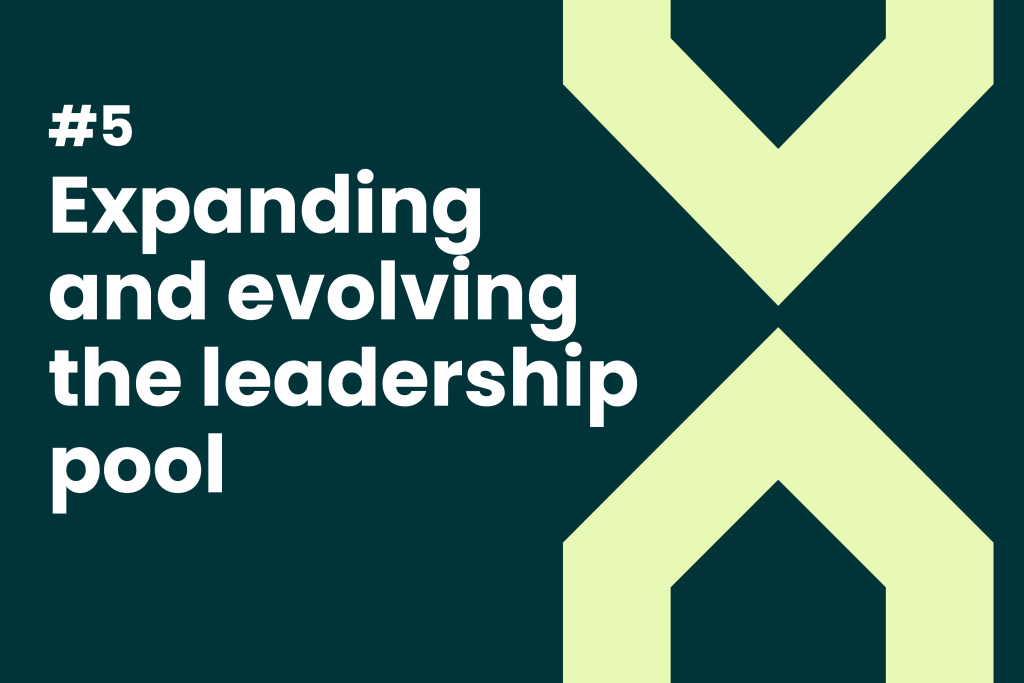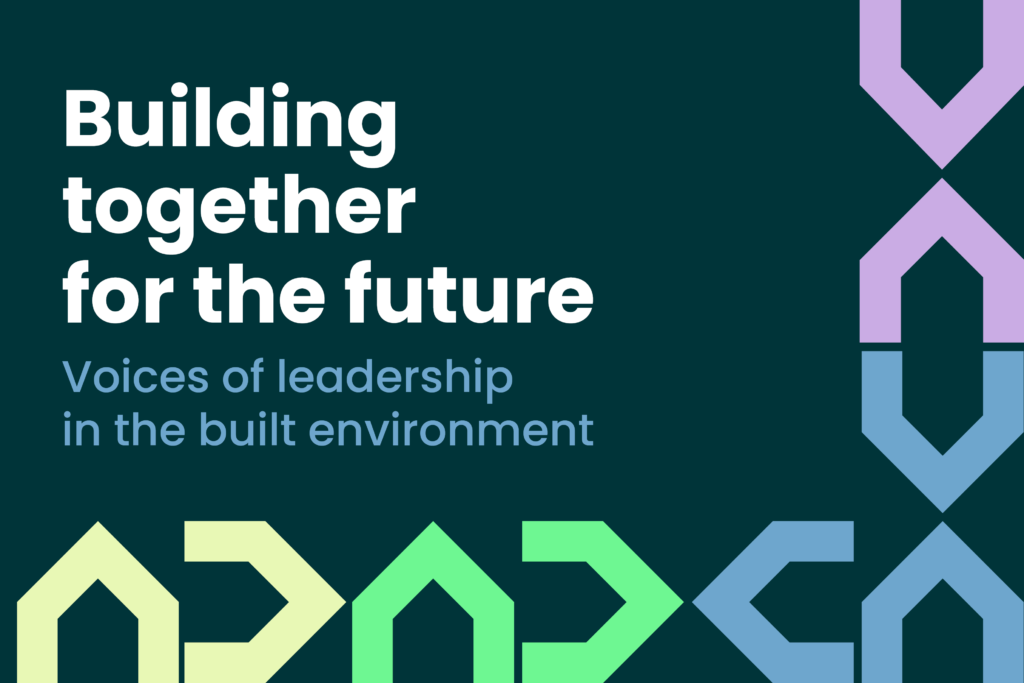
A series of insights from friends of the firm and long-standing leaders across the Built Environment
This final article from our discussion series with a group of industry leaders across the Built Environment considers what the next generation of leadership will be focused on, where they are being identified and the skills they require.
Leadership will be integral to the evolution of the sector over the next decade, and importantly it is also reflective of a changing world where environmental and social responsibility are as vital as economic resilience.
We are hugely grateful to our contributors for their time and valuable insights, including:
- Andy Hulme, Group Chief Executive, The Hyde Group
- Emily Cox MBE, Chair, Gentoo Group
- Hugh Seaborn, Chief Executive, Cadogan Estates
- Muyiwa Oki, RIBA President and Architect
- Paul Fiddaman, Chief Executive, Karbon Homes Group
- Phil Andrew, Chief Executive, Orbit Housing Group
- Richard Donnell, Executive Director, Houseful
- Professor Yolande Barnes, Chair, Bartlett Real Estate Institute, UCL
Engaging early to evolve
Change and evolution in the future can only come from action taken in the present. The next generation of leaders is already working, and the outgoing generation is doing more and more to bring them forward and encouraging change to the status quo.
However, in a sector with such a significant impact on the entire population, it is not enough to think about the next generation alone, we need to be planning for decades to come. The need to engage and importantly excite, young people early is going to be pivotal: one interview suggested, “we have a great story to tell, and I don’t think we are doing that clearly enough, or early enough.”
This ideally should be done at a school level and continued through to further and higher education. Courses and curricula in areas such as architecture, surveying and engineering, are lengthy and will become more and more expensive. They require considerable commitment and are very competitive, which can create barriers to entry, and that will eliminate certain cohorts. “We need to look at how we diversify the way people enter the sector, or we will face a serious skills shortage at so many levels,” said one interviewee.
Apprenticeships, consolidated courses and diversification of qualifications are very important mechanisms to widening both the pool entering the sector, and ultimately expanding the potential and opportunity for future leaders to be identified. There are many significant sectors who have widened their talent pools by innovating in their entry approach and these can be learned from – retail, customer service, finance and technology, as examples.
And while no one has the perfect solution, there are great examples of strides being made and there is much to consider in the model of other sectors. Professional bodies and membership organisations arguably have a very important role to play here, to support many different avenues of entry and engagement. It is a broad sector with many differing drivers, but one of long-term prosperity is a collective vision, and this presents the perfect opportunity for collaboration.
Prioritising leadership development
In order to bring forward the best leaders, leadership in itself needs to have a greater profile. It has an impact, in all its forms on us all and we need to be thinking about how that translates through to the next generations. It is important to encourage enthusiasm and progression for the future and develop skills in leaders who can articulate that well, but also demonstrate how they can deliver on it too.
Leadership needs to be understood better, and there is a need to be careful that it doesn’t become an overly operational role. Strategy, vision and a desire to collaborate were highlighted clearly as essential and that is where succession planning and investment in leadership training becomes crucial. Encouragement of entrepreneurialism was also discussed as important, culturally less apparent in the UK, but arguably more important than ever to embed in future leaders in a shifting economic and geo-political environment.
One leader was very clear on the importance of growing talent from within their own organisation and believes that this is absolutely key to embedding values and vision. But that does require a more diverse talent pool at the offset to expand the perspectives and experiences for future leadership: “We believe in growing diversity organically and bringing people along and up. That is the most powerful way to bring change across the organisation”.
The emphasis on leadership cannot all be industry focused either. It is dependent to a degree on good leadership from government too to get the best from one another. To make an impact and bring about change, governments need to be demonstrating their ability to lead but also to listen and ask the right questions to identify how they can find the right solutions for the future together with the industry leaders.
Time to move the dial
The built environment is a sector that seems almost paradoxical at times. In one view it is innovative and world-leading, and in another it is considered traditional and somewhat intransigent. The shift away from the latter is hard, and no-one denies that, but it was very clear amongst our interviewees that this change must come.
The need to be more diverse, not just at a leadership level, but across organisations is essential. Not only to be more representative of the customer and community base they build for and support, but importantly to bring about changes that are needed to drive a sustainable future.
That requires different ways of thinking, skilling and leading. It needs transparency, honesty and a commitment at leadership level to bring about that change – be that in recruitment, marketing and in delivery. The narrative has to be clear, and it is incumbent on leaders to articulate a vision for change openly and enthusiastically. The demonstration that people who live, work and play in these communities are important and represented properly is crucial: “We need to get to a position where a customer who questions why we made a decision, can be shown that it wasn’t due to a lack of representation or real understanding of their situation.”
Diversity in its many forms is being considered very broadly across the sector, and that most definitely is a priority today, but will be even more so in the future. “We need more visible examples of diverse leadership at executive and non-executive level, that is the only way we will bring change.”
To introduce a more diverse workforce will require a more flexible approach to working patterns and operating models, it was suggested. A traditional five-day week based on site or in an office is not going to achieve a greater balance, and while there are limitations to that, particularly where physical presence in construction and repair are needed, there are many innovative and interesting examples that are already being integrated across organisations all over the country. Leaders need to be showing a commitment, and their own examples of how different ways of working can and do work, to shape the organisations and communities of the future.
Adviser view
If one vital job of leaders is to create a vision of the future in which teams and partners feel invested, then another job is to consider how those teams and partners are changing, and what it takes to energise and unite them.
As control and budgets around placemaking are being devolved – at least in some parts of the world – and connected ever more strongly into communities, the challenge and opportunity in stakeholder mapping and engagement changes. We are also seeing more and more emphasis on infrastructure-led development and on affordable mixed-tenure housing, and this will require big-picture and long-term thinking, an understanding of a more diverse customer base, and extensive partnership working.
In order to help create the leadership models and thriving communities of the future, we will need leaders who are fundamentally collaborative, inclined to listen and adapt, who are data orientated but also sensitive to issues and narratives not easily captured on a graph.
Talk to us about any leadership challenges you have or gaps in your team, or if you are interested in developing the listening and collaboration skills amongst your key leaders. It can be illuminating and valuable work.
Committed to Leadership Excellence in the Built Environment
Our Built Environment practice group is committed to finding and supporting excellent and authentic leaders across infrastructure, local and regional development, housing and transport to deliver tangibly positive benefits for existing, emerging and new communities across the UK. To find out more about how we can support your organisation’s leadership development and appointments, please get in touch with Hannah Scarisbrick or Ginny Jones in our team.

All chapters:
Chapter 2 – Industry obstacles and how we can challenge them together
Chapter 3 – A post-budget insight
Chapter 4 – Priorities for the next decade

